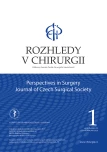Use of nuclear medicine methods in surgical treatment of lumbar spine degeneration
Authors:
R. Kaiser; P. Vaněk; K. Saur
Authors‘ workplace:
Neurochirurgická a neuroonkologická klinika 1. lékařské fakulty Univerzity Karlovy a Ústřední vojenské nemocnice, Praha
Published in:
Rozhl. Chir., 2020, roč. 99, č. 1, s. 46-50.
Category:
Case Report
doi:
https://doi.org/10.33699/PIS.2020.99.1.46–50
Overview
Introduction: Chronic back pain (CBP) is a very common symptom. Multiple modalities are used in its evaluation. However, according to current evidence, none of them can be used with certainty to predict the success of fusion surgery. Given the growing experience with bone tissue examination using the methods of nuclear medicine, we have used this possibility in patients with CBP without disc herniation, degenerative spinal stenosis or instability.
Case reports: We present case reports of 11 patients who underwent lumbar fusion (during two years period) for degenerative disc disease or facet arthropathy with adequate activity on PET or SPECT/CT examination. Rolland-Morris Questionnaire (RMQ), Oswestry Disability Index (ODI), and Visual Analogue Scale (VAS) were filled out pre-operatively and 24 months after surgery.
Results: Six patients after one-level stabilization for active osteochondrosis and one for active facet arthropathy improved on average by 82% (64–92%) in RMQ, by 72% (48–100%) in ODI and 75% (55–100%) in VAS. Results in cases after multilevel stabilizations were slightly worse, but still very significant in most parameters. Only one patient with the most severe morphological and clinical findings did not benefit from surgery.
Conclusion: In 10 out of 11 patients, the lower back pain and quality of life improved significantly after lumbar fusion performed in levels diagnosed by PET or SPECT/CT. These methods certainly have their place in the evaluation of CBP, especially in the case of unclear findings or multiple degenerative changes.
Keywords:
SPECT/CT – back pain – Modic changes – spinal fusion
Sources
- Deyo RA, Mirza SK, Martin BI. Back pain prevalence and visit rates: estimates from U.S. national surveys, 2002. Spine 2006;31:2724–2727. doi:10.1097/01.brs.0000244618.06877.cd.
- Russo VM, Dhawan RT, Dharmarajah N, et al. Hybrid bone single photon emission computed tomography imaging in evaluation of chronic low back pain: Correlation with Modic changes and degenerative disc disease. World neurosurg. 2017;104:816–823. doi:10.1016/j.wneu.2017.03.107.
- Varlotta GP, Lefkowitz TR, Schweitzer M, et al. The lumbar facet joint: a review of current knowledge: Part II: diagnosis and management. Skelet radiol. 2011;40:149–157. doi:10.1007/s00256-010-0984-3.
- Willems PC, Staal JB, Walenkamp GH, et al. Spinal fusion for chronic low back pain: systematic review on the accuracy of tests for patient selection. Spine J. 2013;13:99–109. doi:10.1016/j.spinee.2012.10.001.
- Boden SD, Wiesel SW. Lumbosacral segmental motion in normal individuals. Have we been measuring instability properly? Spine 1990;15:571–576.
- Mobbs RJ, Phan K, Malham G et al. Lumbar interbody fusion: techniques, indications and comparison of interbody fusion options including PLIF, TLIF, MI-TLIF, OLIF/ATP, LLIF and ALIF. J Spine Surg. 2015;1:2–18. doi:10.3978/j.issn.2414-469X.2015.10.05.
- Stratford PW, Binkley J, Solomon P, et al. Defining the minimum level of detectable change for the Roland-Morris questionnaire. Phys Ther. 1996;76:359–365.
- Eck JC, Sharan A, Ghogawala Z, et al. Guideline update for the performance of fusion procedures for degenerative disease of the lumbar spine. Part 7: Lumbar fusion for intractable low-back pain without stenosis or spondylolisthesis. J Neurosurg Spine 2014;21:42–47. doi:10.3171/2014.4.SPINE14270.
- Fritzell P, Hagg O, Wessberg P, et al. 2001 Volvo award winner in clinical studies: Lumbar fusion versus nonsurgical treatment for chronic low back pain: a multicenter randomized controlled trial from the Swedish Lumbar Spine Study Group. Spine 2001;26:2521–2532.
- Jensen TS, Karppinen J, Sorensen JS, et al. Vertebral endplate signal changes (Modic change): a systematic literature review of prevalence and association with non-specific low back pain. Eur Spine J. 2008;17:1407–1422. doi:10.1007/s00586-008-0770-2.
- Esposito P, Pinheiro-Franco JL, Froelich S, et al. Predictive value of MRI vertebral end-plate signal changes (Modic) on outcome of surgically treated degenerative disc disease. Results of a cohort study including 60 patients. Neuro-Chir. 2006;52:315–322.
- Matar HE, Navalkissoor S, Berovic M, et al. Is hybrid imaging (SPECT/CT) a useful adjunct in the management of suspected facet joints arthropathy? Int Orthop. 2013;37:865–870. doi: 10.1007/s00264-013-1811-y.
- Pneumaticos SG, Chatziioannou SN, Hipp JA et al. Low back pain: prediction of short-term outcome of facet joint injection with bone scintigraphy. Radiol. 2006;238:693–698. doi:10.1148/radiol.2382041930.
- van der Bruggen W, Bleeker-Rovers CP, Boerman OC, et al. PET and SPECT in osteomyelitis and prosthetic bone and joint infections: a systematic review. Sem Nucl Med. 2010;40:3–15. doi:10.1053/j.semnuclmed.2009.08.005.
- Mičánková Adamová B, Hnojčíková M, et al. Oswestry dotazník, verze 2.1a – výsledky u pacientů s lumbální spinální stenózou, srovnání se starší verzí dotazníku. Cesk Slov Neurol N. 2012;(75)108:460–467.
Labels
Surgery Orthopaedics Trauma surgeryArticle was published in
Perspectives in Surgery

2020 Issue 1
Most read in this issue
- A review of possible complications in patients after decompressive craniectomy
- Atlanto-occipital dissociation
- Transpedikulární fixace s augmentovanými fenestrovanými šrouby u osteoporotických fraktur páteře
- History, development and use of classification of thoracolumbar spine fractures
